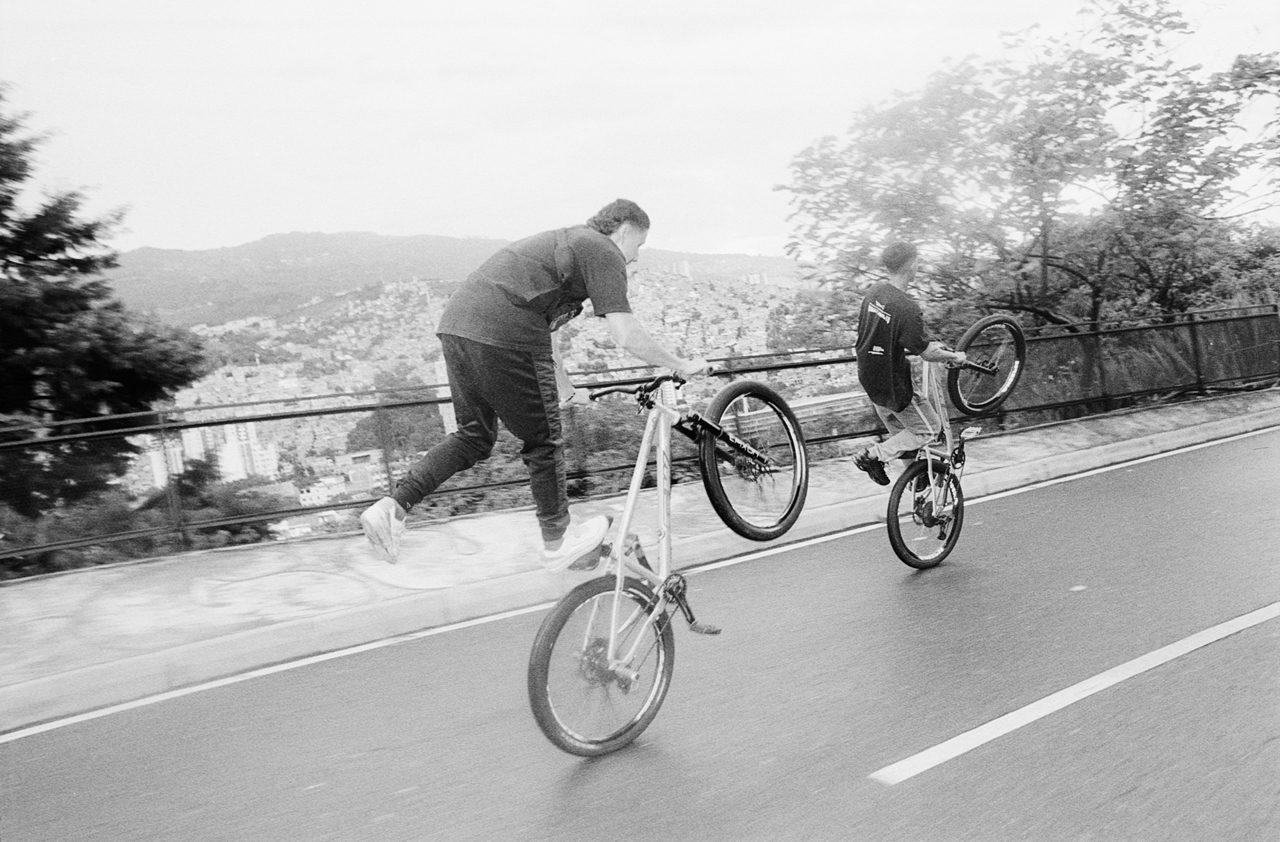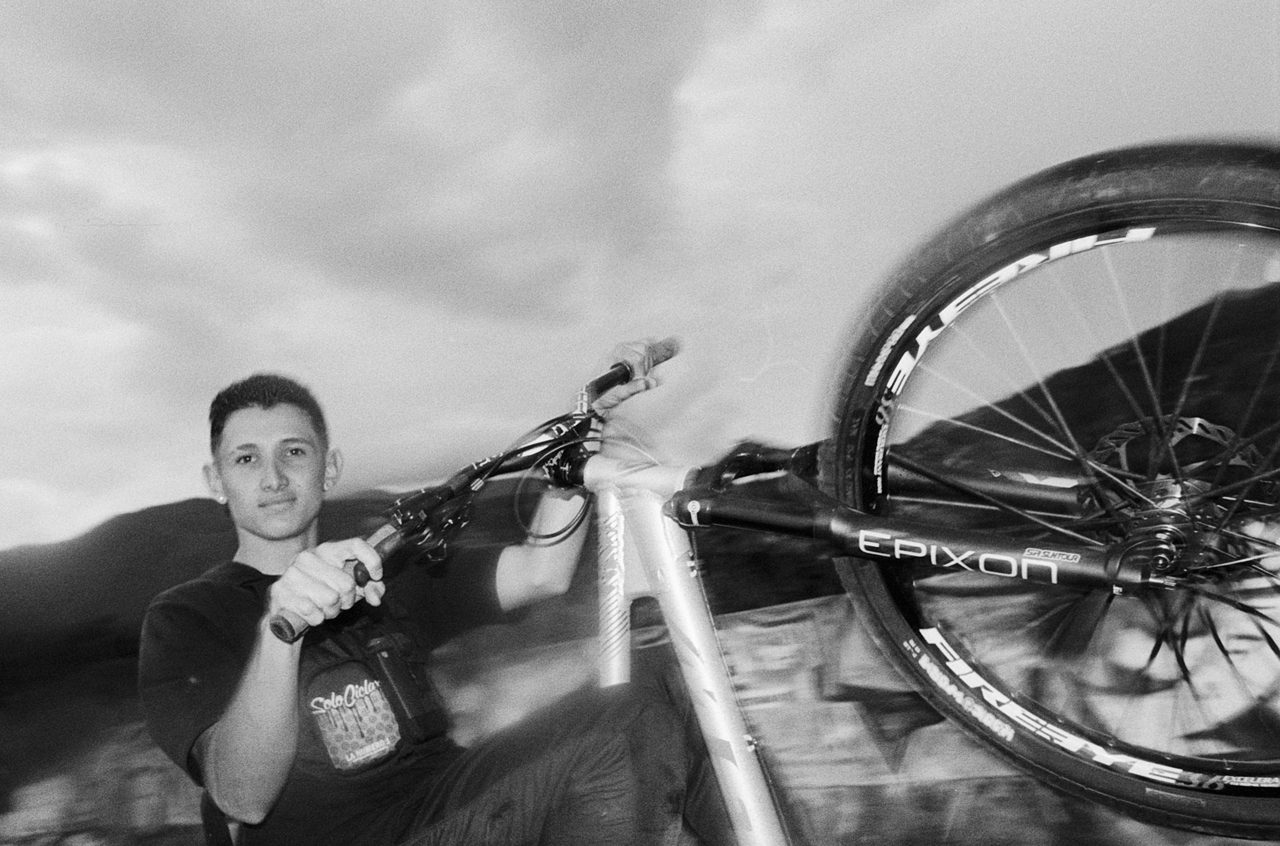Colombian Bikelife Posted On 10th December 2024 To Magazine & Stories


Wilber (@ccs_wilber) wheelies down a hill in Medellin.
BikeLife
The first time I learned about Bikelife was at Parque Nacional, Bogotá’s most emblematic park. It was a Sunday and there must have been at least a hundred of them. They almost all fit the same profile: very young, baggy clothes, no helmet. A disproportionate number sported ‘El 7’, a kind of neo-mullet that’s popularity in Colombia predates the current mullet resurgence in the rest of the world.

12-o’clock wheelies
Every now and then, they’d unceremoniously pull their mountain-BMX hybrids into deep, nearly 12-o’clock wheelies that they seemed capable of holding forever. Some took it further, standing on the seat or throwing their legs over the handlebars. I was amazed, but the other pedestrians didn’t even seem to notice.

Tiago pulls a particularly deep wheelie.
There’s no Wikipedia page
The history of ‘Bikelife,’ or ‘Stunt’ as it’s sometimes called, isn’t easy to find—there’s no Wikipedia page. It seems to have emerged sometime in the 2010’s and spread quickly through urban centers around the world thanks to social media. However it started, the presence of Bikelife is now ubiquitous in Colombian cities, which probably explains why the Bogotanos at Parque Nacional were unfazed by the riders' acrobatics.


Revolves around the wheelie
Unlike BMX, which is synonymous with big air and grinds, Bikelife revolves around the wheelie. The more difficult the wheelie variation, and the more style with which it’s executed, the more followers a rider is likely to pick up on social media. Medellin’s own ‘La Plaga’ is one of the most followed riders in the world with over 1.1 million on Instagram.

I just think it looks cool
I wish I had some profound explanation for my interest in photographing Colombian Bikelife, but honestly I just think it looks cool. Everything about it is photogenic: the high speed tricks, the mountainous urban backdrops, even the mullets. Most importantly, however, was that I got access. A few of Medellin’s best Bikelife riders answered my DMs right before I arrived there for a work trip. They told me they’d be happy to have me around at their weekend hangouts.

This was going to be a challenge
I knew from the get go that this was going to be a challenge. Shooting fast action is hard enough on modern digital cameras with advanced autofocus systems and blazing fast frame rates—you take thousands of shots in hopes of getting a handful of keepers. But I didn’t have a modern digital camera. I had a Canon Rebel TI and two rolls of film: Kentmere 100 and Kentmere 400. Making matters worse, my flash had just broken so I wouldn’t be able to freeze the action.

The first hangout
At the first hangout, I spent most of my time photographing Diego, an up-and-coming biker who’d just recovered from a nasty fall he’d taken a few months before that left him with a broken arm.

I think this photo is solid, but it would be so much better with flash. Diego would pop off the frame, the one stop push exaggerating the high contrast that hard flash adds to a subject.
I decided to push the Kentemere 100
Diego killed it. Me, less so. I decided to push the Kentemere 100 one stop to keep my shutter speeds higher, but the added contrast didn’t mesh with the combination of full sun and Diego’s black outfit. In retrospect, I’d have been better off tolerating some motion blur in exchange for the high dynamic range of Kentmere 100 shot at box speed. The other problem was my lens, a Canon 28mm f1.8. 28mm may seem wide, and it is for most subjects, but up-close bikelifers are very hard to keep in frame. Now I realize why analog-era skateboard photographers were so fond of fishangles—sure it’s a cool look, but more importantly super-wide angles give you plenty of room for error.

The flash changed everything
The next session went much better for three reasons: There was cloud coverage that looked cool and made getting proper exposures easier. The bikers’ had a friend with a motorcycle who let me ride on the back to keep pace with the subjects. And, most importantly, I discovered that my camera had a pop-up flash—one of many reasons to use cheap cameras. The flash changed everything. I could freeze motion, ensure proper exposure, and I just love the look of hard flash in black and white.

Thiago (@tiago.bikelife) never looks flustered, even performing the most complex and risky wheelies.
My Favorite
I was using Kentmere 400, my favorite black and white film. It was the first roll I ever shot back in 2022, and I’ll admit that I’d bought it because it was the cheapest. However, after trying a bunch of more expensive black and white film stocks, I realized I preferred the grain structure and relatively high latitude of Kentmere 400. After the sesh, Wilber and Thiago invited me to get sweet oatmeal drinks and pastries. Apparently, it’s kind of a Medellin Bikelife tradition.

No flash here. Gives you a good idea of Kentemere 400's dynamic range and tonality.
©Henry Craver
About The Author

Henry Craver
Henry Craver runs the YouTube channel THROUGH THE GLASS, where he photographs different cultures around the world on 35mm film. Before becoming a ‘creator’, Henry worked as a photojournalist in the U.S., Mexico, and Ukraine.
YouTube: https://www.youtube.com/@THROUGHTHEGLASSS
Instagram: https://www.instagram.com/throughtheglasssss/profilecard/?igsh=OG9zdGV3dnIxMjFk







